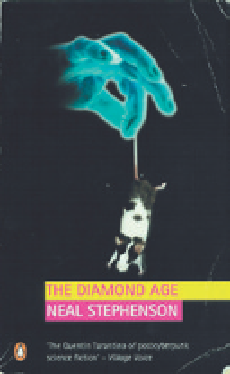Information Technology Reference
In-Depth Information
To investigate murders, the police deploy an impressive array of nanogadgets -
nanomolecular body armour, forensic robotic dust mice, nanowatchers embed-
ded in the paint, and flechette darts designed to change shape and burrow
into a wound. Self-organizing nanotechnology also gives a new twist to three-
dimensional printing and concealed weapons:
She patiently watched the nano at work. The metal tubing of the bootrack
had crumpled under the gray coating. The resulting pool of paste and
deconstructed objects was contracting into a round complexity. Nano was
forming an object within that convexity like an embryo with an egg.… The
convexity grew lumpy now. She could make out the basic shape. To one side,
excess raw material was being pushed into lumps of raw slag. Nano withdrew
from the slag. Handle, loader, firing chamber, barrel and flightguide. To one
side of the convexity a second lump not slag was forming. Spare clip.
24
A similar vision of the future is found in Neal Stephenson's novel
The Diamond
Age
(
Fig. 17.21
), subtitled
A Young Lady's Illustrated Primer
. Nanotechnology is now
pervasive and is used for art and recreation, feeding and clothing the masses,
nanowarfare between clouds of “smart” fog, and the intelligent and interactive
“primer” of the title. The primer is an illicit subversive miracle “book” that
teaches the reader everything from mythology and science to martial arts and
survival techniques:
Fig. 17.20. The cover of Greg Bear's
Queen of Angels
first published in 1990.
The novel is a murder story set against a
backdrop of nanotechnological miracles.
In a footnote to the novel, the author
reminds the reader that “The nanotech-
nology described here is highly specula-
tive” and refers to K. Eric Drexler's
visionary topic on nanotechnology,
The
Engines of Creation
.
A leaf of paper was about a hundred thousand nanometers thick; a third of a
million atoms could fit into this span. Smart paper consisted of a network of
infinitesimal computers sandwiched between mediatrons. A mediatron was a
thing that could change its color from place to place; two of them accounted
for about two-thirds of the paper's thickness, leaving an internal gap wide
enough to contain structures a hundred thousand atoms wide.… Here resided
the rod logic that made the paper smart. Each of these spherical computers
was linked to its four neighbors, north-east-south-west, by a bundle of flexible
pushrods running down a flexible, evacuated buckytube, so that the page as
a whole constituted a parallel computer made up of about a billion separate
processors.
25
A world populated with millions of nanodevices requires some adjustment to
our present ways of thinking:
Aerostat meant anything that hung in the air. This was an easy trick to pull
off nowadays. Computers were infinitesimal. Power supplies were much more
potent. It was almost difficult not to build things that were lighter than air.
Really simple things like packaging materials - the constituents of litter,
basically - tended to float around as if they weighed nothing, and aircraft
pilots, cruising along ten kilometres above sea level, had become accustomed
to the sight of empty, discarded grocery bags zooming past their windshields
(and getting sucked into their engines).
26
Fig. 17.21. The cover of
The Diamond Age
by Neal Stephenson. The subtitle is
A
Young Lady's Illustrated Primer
, referring
to an intelligent topic crammed with
nanotechnological miracles.
A last example of the dark side of nanotechnology is explored in the novel
Prey
by Michael Crichton, which describes a nightmare “grey goo” scenario. The
story concerns an ambitious start-up company. The company has a lucrative
military contract to produce nanodevices in bulk quantities that have both


Search WWH ::

Custom Search